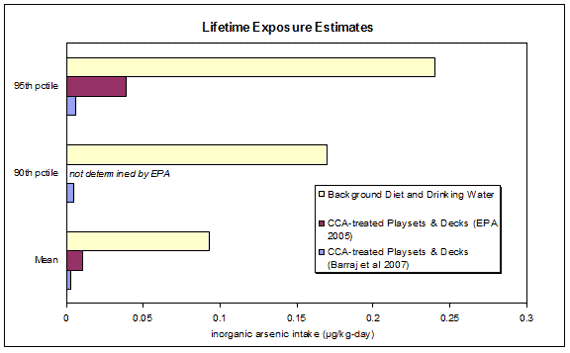|
Current as of April 2008
The Safety of Chromated Copper Arsenate (CCA)-Treated Wood
Chromated copper arsenate (CCA) is a wood preservative that protects wood against deterioration due to termites and fungal decay. CCA was invented in 1933 and has been used extensively since the mid 1970s. Since the preservative is a pesticide, its production and use have been regulated by the U.S. Government for over sixty years, first by the U.S. Department of Agriculture, with which CCA was registered in the 1940s, and then by the Environmental Protection Agency (EPA), which was created in 1970 and took over the responsibility for pesticide regulation. EPA, which has reviewed the safety and effectiveness of CCA since 1970, has not at anytime determined that CCA-treated wood poses an unreasonable risk to human health and the environment.
In evaluating the safety of CCA-treated wood, primary attention has been given to the arsenic component. Arsenic is a naturally occurring element - found in soil, food and water. Studies have established that the potential level of arsenic exposure from CCA-treated wood is significantly lower than the levels adults and children are exposed to each day from background sources such as food and drinking water. It is important to keep in mind that the arsenic component of CCA is complexed within the wood itself and is intended to remain within the wood.
CCA-treated wood is used in marine facilities (pilings and structures), utility poles and cross arms, pilings for terrestrial and freshwater uses, commercial and agricultural construction (primarily foundations), and highway structures (such as bridge components, guardrails, and posts). CCA has a well-proven history of providing consistent long life to preserved wood products, both through over 70 years of laboratory and field testing as well as successful long-term use of products in challenging environments. Compared to non-wood products, the benefits of wood products include lower density, ease of field modification, structural flexibility and durability, and aesthetic appeal. CCA preservative adds benefits to wood including proven efficacy, long product life, low cost, and helping to preserve an important natural resource, wood, by extending its useful life.
Previously, CCA-treated wood was approved for use in numerous residential uses, including for construction of decks and playground equipment. In 2002, registrants of CCA voluntarily removed those uses from their labels, because of changes in the market and entry of other materials. EPA approved those label changes, which became effective as of January 1, 2004. Previously constructed structures still remain in use.
As part of the registration and continued review of the preservative, EPA has spent many years examining CCA-treated wood. EPA recently completed an assessment of potential risks to children who may play on CCA-treated playsets and decks. EPA does not believe there is any reason to remove or replace CCA-treated structures, including decks or playground equipment. EPA is not recommending that existing structures or surrounding soils be removed or replaced. Further, EPA has not recommended that there is any need to take steps such as applying coatings to minimize exposure.
The WPSC agrees with the conclusions of EPA and the US Consumer Products Safety Commission (CPSC) that existing structures constructed with CCA-treated wood present no hazard to the public. Those conclusions are based on extensive evaluations and considerations. The very low levels of arsenic to which children playing on those structures potentially may be exposed are far below and indistiguishable from the levels to which children are exposed from naturally occurring sources in diet and drinking water:
Comparison of Lifetime Exposure Estimates to Inorganic Arsenic from Natural Sources (Diet and Drinking Water) to Estimates for Children Contacting CCA-Treated Playsets and Decks.

After Tsuji, J., L.J. Yost, L.M. Barraj, C.G. Scrafford, and P.J. Mink. 2007. Use of background inorganic arsenic exposures to provide perspective on risk assessment results. Reg Toxicol Pharmacol 48(1):59-69.
Read more about the assessment of the use of CCA-treated wood in existing structures.
Coatings often are used on wood used outdoors. Coatings are designed to maintain the aesthetic appearance of wood. Water repellents may be used for the purposes of appearance and moisture protection. The use of such products is not necessary to extend the life of CCA-treated wood, nor are coatings necessary from a safe-handling standpoint. There is no scientific evidence to support the use of coatings for safe-handling of CCA-treated wood. EPA does not recommend the use of coatings for such purposes.
Read more about coatings for CCA-treated wood in existing structures.
©2003-2018 Wood Preservative Science Council.
All Rights Reserved.
|
